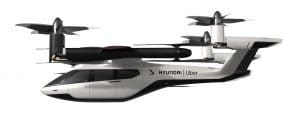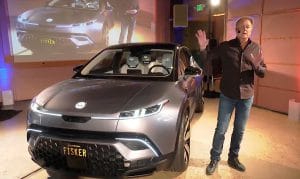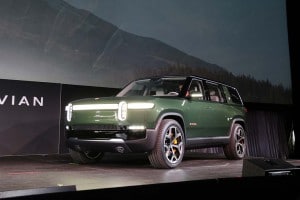And you thought CES was all about TVs, smartphones, cameras, drones and other consumer electronics? Well, if you consider the automobile as a “smart device on wheels,” as Byton CEO Daniel Kirchert likes to say, then you’re probably right. And that’s a good thing considering that nearly half of this year’s Consumer Electronics Show was made up of products related, in one way or another, to the automobile.
With that much to check out, coming up with a best-of list was no easy task, and we’ll admit we’ve likely missed a year stand-out products and technologies. But this list is still a good representation of what stood out at CES 2020, including not only products that we’d like to drive or have in our car but others that were strange and quirky enough to catch our attention.
Let’s start off with Products Coming to Market Soon:
The Byton M-Byte made its debut in concept form two years ago and was back in production trim at CES 2020. There were only minor tweaks to the exterior, and the cabin retained the distinctive, 48-inch video instrument panel that drew so much attention at the introduction of the all-electric concept at CES 2018. But, now, there will be plenty to use that screen for, including infotainment content from the likes of AccuWeather and ViacomCBS, the latter planning to stream its vast catalog of movies and TV show.
The Fisker Ocean marks the second try by Danish designer Henrik Fisker, his original Fisker Motors and its Karma plug-in hybrid plunging into insolvency in 2013. The Ocean is an all-electric SUV expected to undercut the Tesla Model S at a base $37,499 – r $379 a month for a lease. Not many details have been released so far, but Fisker expects the Ocean will deliver up to 300 miles on its 80 kWh battery pack.
Until recently, it looked like the Faraday Future FF91 wouldn’t make it into production, the California start-up running into a series of financial setbacks that even forced it to abandon its planned factory near Las Vegas. With a fresh cash infusion, however, Faraday officials drove a prototype of the battery-car from L.A. to Los Vegas to show its range – the BEV finishing the run with over 100 miles left in its battery pack. Barring setbacks, expect to see the FF91 on sale within a year and followed by two other, smaller models.
Concept Cars Worth Checking Out
Nissan’s Ariya show car actually was introduced overseas earlier this year but we learned a lot more about the electric SUV at CES – among other things, expecting that a production version of the battery-electric SUV will make its debut in production form later this year. Some of the features on the concept won’t carry over, notably including its autonomous drive system – though the retail Ariya will get a significant update of Nissan’s current ProPilot driver assistance system.
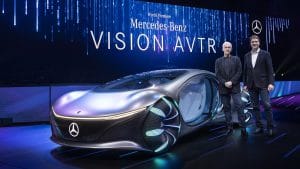
The Mercedes-Benz Vision AVTR was inspired by the film Avatar, its director James Cameron helping introduce the electric show car.
The Mercedes-Benz Vision AVTR looks like it emerged from the movie, Avatar – and, no surprise, the German automaker turned to the hit film’s director, James Cameron, for help in its design. Fully electric and autonomous — it doesn’t even have a steering wheel – we don’t expect to see the AVTR go into production but it showcased some intriguing technology, including a control system that bionically links to the driver. It also offered both augmented and virtual reality technology to give passengers Avatar-influenced “experiences” while riding.
The Hyundai S-A1 isn’t your typical automotive concept vehicle. That’s because it’s a mock-up of a flying taxi, part of a new partnership between the Korean carmaker and Uber. If all goes according to plan, the ride-sharing giant wants to kick off its new flying taxi service, Uber Elevate, in three cities in 2023. The S-A1 likely won’t be ready that soon but Hyundai does have an advantage over other partners like Boeing and Embraer, said Uber, the ability to mass produce the S-A1 once it wins FAA certification.
Cars as Platforms for Technology
Sony delivered perhaps the biggest surprise of the show, at least when it came to four-wheeled products. The Sony Vision-S prototype was built in collaboration with supplier Magna-Steyr but, at this point, it seems unlikely Sony actually plans to put it into production. Instead, it needed a showcase for all the automotive technology it is developing. There were 31 different sensors onboard, several video screens, a slick infotainment system and, running it all, Sony’s new Vision-S connected car platform.
Rivian wants to get its first two products, the R1T pickup and R1S sport-utility vehicle, into production later this year. When that happens, you’ll have a friendly voice assistant tagging along in the form of Amazon’s Alexa. The wildly popular technology will be built into Rivian’s infotainment system and not only will be able to open your garage door, turn on lights at home and raise the thermostat but also control various vehicle functions. Amazon last year was part of a consortium investing $750 million in Rivian which will provide the online buying service 20,000 all-electric delivery vehicles.
The Land Rover Defender is back – set to make its first appearance in the U.S. in 22 years. The big SUV is expected to still be able to handle the most rugged of trails, but it will do that in style and comfort. The Defender will feature a slick new infotainment system, Pivo Pro, capable of streaming audio through a 4G LTE connection. It also will become the first automobile with twin modems, a second dedicated to onboard vehicle functions, such as over-the-air updates of its software.
Tech We Wish Our Cars Had Already
The Bosch Virtual Visor is clearly the most significant update of the automotive Visor in a century and uses an LED screen that can go from transparent to opaque to keep the sun out of a driver’s or passenger’s eyes. It also uses a camera system to figure out how much of the screen to darken at any given moment.
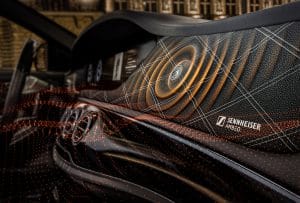
The new Continental-Sennheiser speakerless sound system works by exciting certain materials in the vehicle.
Supplier Gentex is lifting a page from Boeing’s Dreamliner, the jet’s electrochromic window shades. The technology is conceptually similar to the Bosch Virtual Visor, though the technology is a bit different. But it takes just a touch of a button to adjust the transparency of your windows or sunroof with the system.
Auto supplier Continental teamed up with audio manufacturer Sennheiser on the Ac2ated Sound system. It’s a revolutionary speakerless audio system for piping entertainment into a vehicle’s interior. Instead of speakers, the system “excites” various panels and parts inside the vehicle interior so that they make an immersive, high-fidelity sound. The system is said to require far less space – and add much less weight – than conventional automotive speakers.
Other Automotive Tech That Caught Our Eyes
Bridgestone revealed a new system that can automatically detect tire wear and alert a driver. The system, it claims, will become particularly important once driverless vehicles take to the road in large numbers.
Several companies revealed solar charging technologies. And, no, they won’t create enough juice so you won’t need to plug in, but Hyundai believes the solar charger that will be available for the upcoming Sonata plug-in hybrid will be able to add as much as 800 miles of power annually.

Toyoda notes that Toyota Toyota CEO Akio Toyoda shows off an image of Woven City, which will be occupied by 2,000 people initially.
Israeli start-up Moodify is one of several companies backed by Toyota to show up at CES this year. The start-up is using neuroscience to develop next-generation scents that will be able to do a variety of things, such as perking you up if you’re driving, or calm you down if they’re over-excited. Moodify White, meanwhile, overwhelms your olfactory system and can block those bad smells in a family hauler. Used car dealers could use the scents to mask out unpleasant odors that would otherwise require a discount on the sale price, Moodify claims.
The Honda Exoskeleton isn’t something that car buyers will care about, but the two systems shown at CES should please folks working at Honda factories by making it easier and less of a strain to perform repeated tasks like bending below a vehicle or having to reach overhead.
Finally, Toyota gets a nod for announcing what was clearly the most ambitious project to debut at CES, Toyota Woven City aimed at creating an entirely new city that will serve as a “living laboratory” to address the many problems challenging urban centers around the world, like pollution, energy supplies and traffic congestion. The automaker said. It will allow autonomous vehicles only, use recycled and sustainable materials for homes and use solar and hydrogen for power. The project breaks ground in 2021 on the grounds of an old Toyota plant near Mt. Fuji, and will have 2,100 residents as part of its first phase.
(What are the most reputable extended car warranty companies?)

